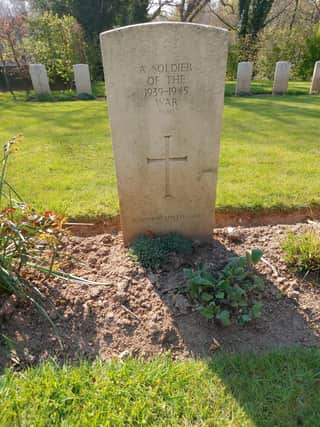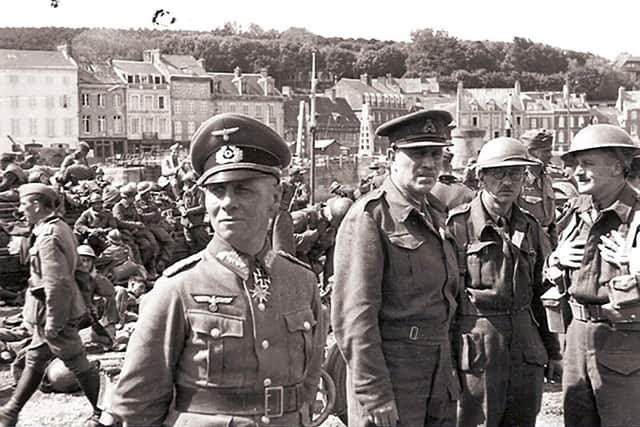St Valery: Lest we forget the sacrifice


Hemmed in on all sides from advancing German forces, the Highland regiments -- whose heroic stubbornness in the face of impossible odds were later recognised -- were forced to surrender while waiting for an evacuation that never came.
Just days before, 150 miles up the coast, 331,000 of their comrades were plucked to safety from the beaches of Dunkirk.
Advertisement
Hide AdAdvertisement
Hide AdThe eventual defeat of the Nazis, at this point, was a long way off as the German panzer division tore through Northern Europe with ruthless, destructive efficiency.


The 51st Highland Infantry Division (the Seaforths, the Camerons, the Black Watch), under the command of the ironically named General Fortune, had been forced to retreat with their French counterparts to St Valery.
At 10am on the 11th June, General Fortune issued the following directive: "The Navy will probably make an effort to take us off by boat, perhaps tonight, perhaps in two nights. I wish all ranks to realise that this can only be achieved by the full cooperation of everyone. Men may have to walk five or six miles. The utmost discipline must prevail.”
But no such rescue mission ever came; there would be no repeat of Dunkirk – nor was it even attempted. Highlanders, not for the first time in the history of British conflict, were sacrificial lambs.
Advertisement
Hide AdAdvertisement
Hide AdNearly 20,000 men from the Highland regiments died in that rearguard action; another 10,000 surrendered to the mercy of the Nazis and were marched off to concentration camps in the east.
A few managed to escape, hiding in the countryside with the help of locals. Back home the families knew not of their fate, alive or dead.
Information was scarce and unreliable and it would be some time before news filtered through of those that did manage to survive and were later liberated from the hell of the concentration camp.
Viewed through the prism of today, it seems almost incomprehensible. The numbers involved, the sheer brutality, the lack of even an attempted rescue; it defies all sense of humanity. But the Second World War, like the First, was the ultimate definition of man’s inhumanity to man.
Advertisement
Hide AdAdvertisement
Hide AdOn the 80th anniversary of St Valery just over a year ago, a series of events were held to commemorate what has become known as “the forgotten Dunkirk”.
It included an estimated 500 pipers across the world sounding out the march “The Heroes of St Valery”, composed by Pipe Major Donald MacLean of Lewis, one of those captured on that fateful day.
He was in the Seaforth Highlanders and was marched east, with thousands of others, along with captured Jews, and spent the next five years at Stallag 344 in Lamsdorf in Poland.
Having survived his ordeal, “Big Donald”, as he was known, a native of Ballantrushal, went on to become a highly-distinguished figure in the piping world and also composed another famous tune, ‘Major Manson at Clachantrushal’, a nod of appreciation to his time in the army and his home village. Donald died aged just 56 when attending Cowal Games in 1964.
But he was by no means the only Lewis piper at St Valery.
Advertisement
Hide AdAdvertisement
Hide AdFighting alongside him was the much younger Pipe Major Donald MacLeod, one of the most respected composers and teachers of piping and whose memory lives on today in the shape of an annual piping competition -- one of the most prestigious on the circuit -- in Stornoway.
He, too, was captured after surrender, but conspired to escape by sliding into a ditch and hiding in the long grass. He avoided re-capture by speaking Gaelic when challenged by German soldiers or sentries. He found his way to the arms of the French Resistance and made it back to Blighty.
After the war he also enjoyed a highly decorated career -- even more so than his friend and comrade Donald MacLean -- and died in 1982 aged 66. It is said that Donald (MacLeod) rarely spoke of his experiences during the war and when asked to draw on his escape would dismiss it by saying they were not interested in the “wee ones”. (It was self-deprecating but also a reference to his friend, the much larger framed other Donald.)
Two Donalds in the same regiment, both from the island, both who survived and both who went to become distinguished pipers – another remarkable facet in a story of limitless incredulity.
Advertisement
Hide AdAdvertisement
Hide AdNEXT WEEK will see the 81st anniversary of St Valery and, following on from the success of last year’s commemoration, a formal initiative is underway to coordinate an annual event.
Dr Claire Armstrong, Chief Executive of The Royal British Legion in Scotland, said that “until last year the battle of St Valery was relatively unknown, but we set that right with commemorations that reached around the world”.
According to local historian Malcolm MacDonald, there were 160 men from the Outer Isles involved at St Valery and a number buried in war graves near the coastal port. They include, he said, “Lance Bombardier Neil Dan MacAulay from 68 Nicolson Road in Stornoway who is interred at Veulettes-sur-mer churchyard. He was not married and was aged 22 when killed.
“There was also John ‘Cuidhlear’ Campbell from 10 Oliver’s Brae in the town, again unmarried and only 20. The Harris and Uist Camerons fought at Abbeville shortly before the retreat to St Valery and all together lost 18 men.”
Advertisement
Hide AdAdvertisement
Hide AdMr MacDonald said: “With the surrender of the French Divisions at St Valery-en-Caux on 12th June 1940, many households in the Western Isles were left in a state of shock, not knowing whether their menfolk fighting with the French in the 51st Highland Division were safe or not. It was not until May 1945 that the first of them came home after five years of captivity.”
As part of efforts to draw more attention to the anniversary, Poppy Scotland (the charity run by the Legion) launched an appeal to identify one of the fallen heroes of the battle. It is -- again -- a chilling and heart-breaking tale.
The charity were approached by St Valery resident Monsieur Patrick Prieur asking for their help.
Recalling a story his late father told him, he said: “A soldier from the 51st Highland Division was hidden by a local family in the village. They bonded, and the family learned that he was a married man with a wife and two daughters waiting for him to return home.
Advertisement
Hide AdAdvertisement
Hide Ad“For several weeks, the soldier remained hidden, but regretfully he was eventually discovered by German troops and marched through the town to the municipal cemetery.
"After being forced to dig his own grave, he was positioned against the cemetery wall and shot.
"His death deeply upset the townspeople— who had been aware of his hiding—and especially my father, who was only eleven at the time.
“In later years, the Franco-British military cemetery was built, and his body was moved there. His grave is marked as ‘Known unto God’, and my father and other villagers tended to it for decades after the war ended.
Advertisement
Hide AdAdvertisement
Hide Ad“My father had been gifted a piece of paper on which the soldier’s name was written, ‘Keller Len Scott’, and this became his prized possession.
"He desperately wanted to find the soldier’s family to tell them what had happened to their beloved and where he was laid to rest, but having very little information, he struggled.
"In 2014 my father passed away and being eager to finish what he started I recently contacted Poppyscotland and the Highland Reserve Forces’ and Cadets’ Association to ask for help.”
According to Malcolm MacDonald it is “highly unlikely” the fallen hero is of island descent, given his name and what we know about the islanders who were at St Valery.
Advertisement
Hide AdAdvertisement
Hide AdBut it is poignant nevertheless and the search appeal comes as part of the wider efforts to establish annual commemorations.
“As the 81st anniversary approaches we want to capture the hearts and minds of the public once more,” Dr Armstrong said. “
We are urging anyone who believes they know of or has any information about our ‘Unknown Solider’—no matter how small—to get in touch.
"We are also inviting pipers to take centre stage again at the 2021 commemorations by leading tributes in their local communities playing ‘Heroes of St Valery’ on 12th June at 10am.
Advertisement
Hide AdAdvertisement
Hide Ad“This brave man fought valiantly for his country and to repay our debt to him for his service would be an honour; not only for Legion Scotland as custodians of remembrance, but for his family, Monsieur Prieur’s father, the people of St. Valery and, ultimately, for all the ‘Unknown Soldiers’ who sacrificed their lives for us.”
Malcolm MacDonald agrees that more should be done to mark “the Forgotten Dunkirk” which had such a profound effect on so many Highland and Islands families and communities
“I firmly believe that we should remember these brave men with an annual St Valery Day on the 12th June,” he said.
“It could be in the evening at Perceval Square to accommodate as many people as possible, with the pipe band, lone piper, bugler, Territorial Army and so on. It would be the right and proper thing to do.”
Advertisement
Hide AdAdvertisement
Hide AdMalcolm is right. Those who have first-hand experience of the Second World War are getting few and far between and commemorations like an annual St Valery Day -- irrespective of local connection -- are hugely important.
A week Saturday (12t), perhaps we should all make an effort to take a moment of reflection and listen to the piping march of the “The Heroes of St Valery”.
Lest we forget.